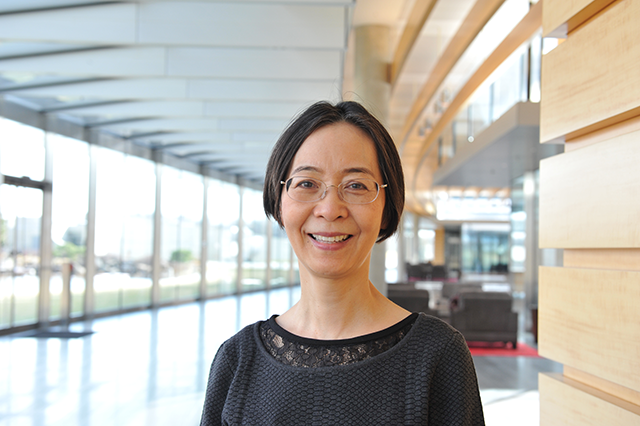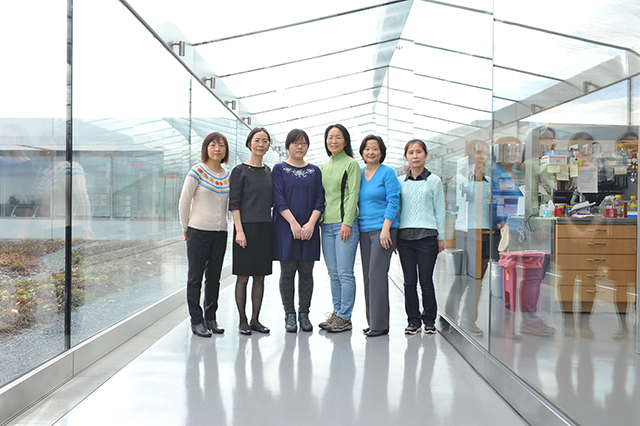There aren’t many work places that require a shower upon entry, let alone head-to-toe protective gear. But for those who work in the Gene Targeting and Transgenic Resource’s “barrier facility” at Janelia Research Campus, it’s unavoidable.
The stringent hygiene rules protect the residents of the facility: hundreds of mice poised for genetic modification. These mice are the product of a service that helps scientists better understand the natural functions and errors in biology. Caiying Guo, director of the transgenic facility, leads the effort, working with a team of experts to genetically tailor mice to study specific types of biological research, like understanding mutations that cause disease or alter behavior.
The facility started as an in-house resource for Janelia scientists, but after a couple of years, Guo thought, “I partner with [HHMI] investigators when they visit Janelia, why not expand the service to the entire group?”
 In 2009, the transgenic facility became an open resource for all investigators, and starting this year, welcomes requests from HHMI faculty scholars. To date, the facility’s team has completed or is working on 160 different mouse line projects with 47 HHMI investigators. Scientists need only email a request – Guo and her team take it from there.
In 2009, the transgenic facility became an open resource for all investigators, and starting this year, welcomes requests from HHMI faculty scholars. To date, the facility’s team has completed or is working on 160 different mouse line projects with 47 HHMI investigators. Scientists need only email a request – Guo and her team take it from there.
“When we get a new request, we work with the scientist to design the project. Or, if they don't have experience in making transgenic mice, we take care of everything for them,” says Guo.
HHMI Investigator Tom Südhof, a neuroscientist and Nobel laureate at Stanford University, has been a long-time partner and has made 29 different mouse lines with Guo.
Südhof’s biggest research effort focuses on neuron-to-neuron communication in the brain. Specifically, he investigates the mechanics of neuronal connections, called synapses. When a synapse forms, two neurons exchange information in the form of a chemical messenger, called a neurotransmitter (neurons that release neurotransmitters are presynaptic; neurons that receive them are postsynaptic). Over time, scientists have learned that calcium ions are key in initiating this chemical correspondence. When calcium binds to a protein called synaptotagmin, it triggers a cascade of events that results in neurotransmitter release – similar to knocking over the first domino.
Once the neurotransmitters have been expelled, the postsynaptic neuron must collect them.
To better understand that process, Südhof enlisted Guo’s help. The two created a special mouse model in which they could monitor certain proteins, such as synaptotagmin, in the postsynaptic neuron with the help of a fluorescent agent, genetically pinned to the protein. The glowing protein revealed an unexpected symmetry: neurotransmitter uptake in the postsynaptic neuron mirrors that of neurotransmitter release in the presynaptic neuron – both processes begin when calcium binds synaptotagmin.
Südhof is applying the findings to learn more about human disease, hoping to further decipher the role of synapse formation and function (or dysfunction) in neuropsychiatric and neurodegenerative disorders.
Along with genetically altering mice to help advance biological understanding, Guo helps scientists apply their research findings to mouse models of human disease. In many cases, researchers might suspect that a mutant gene causes a disorder, and they will ask Guo’s team to tweak the mouse’s DNA to test the theory.
 What’s less common, however, is a suspicion that one mutation might cause four diseases. About a year ago, Paul Taylor, an HHMI investigator at St. Jude Children’s Research Hospital who studies the neurobiology of disease, approached the transgenic facility’s team with precisely that idea.
What’s less common, however, is a suspicion that one mutation might cause four diseases. About a year ago, Paul Taylor, an HHMI investigator at St. Jude Children’s Research Hospital who studies the neurobiology of disease, approached the transgenic facility’s team with precisely that idea.
His suspicion arose from an unusual observation made in his former clinical neurogenetics practice. In some of the families he cared for, Taylor found that some family members fell ill to clinically distinct diseases that seemed to come as a package – amyotrophic lateral sclerosis (ALS), frontotemporal dementia, inclusion body myopathy, and Paget’s disease of bone. Upon closer look, Taylor found that despite the tremendous clinical variability, each of the affected members of the family shared a common gene mutation. “There’s something special about this class of genetic mutation that makes the clinical manifestations so highly variable,” Taylor says. “We want to understand how it works.”
Curious to see how genetic background influences disease variability, Taylor introduced the mutations into genetically identical mice. “At the time I wanted to start investigating this, my lab didn’t have any expertise in introducing mutations into mice through gene editing,” Taylor says. “When I got word that Janelia was opening their transgenic service to investigators, I fired off an email within 10 minutes.”
Together, Taylor and Guo mulled over the molecular details and then successfully introduced a set of gene mutations into a handful of mice. Now, Taylor and his group are in the process of transferring the mice to St. Jude to continue their research.
Guo says that offering this type of customized service to other HHMI scientists helps her forge new relationships – and grow as a scientist.
“I like that, with this program, my group is exposed to a lot of different types of science, including some projects that are very complex,” Guo says. “It helps me open my mind and learn from others, and to me, that’s the best part.”
